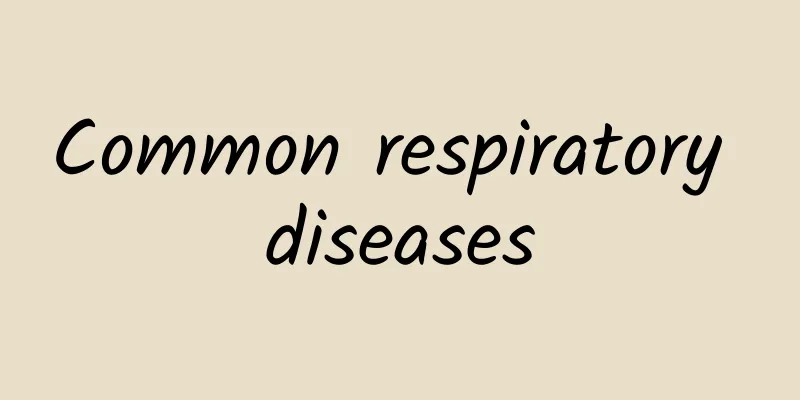Common respiratory diseases

|
Respiratory diseases are a type of disease that causes trouble to many people in life. The main sites of disease occurrence are the bronchi and lungs, which are closely related to human breathing. In recent years, with the intensification of air pollution, the treatment of respiratory diseases has also become a major type of disease in the medical field. Therefore, for people with respiratory diseases, timely identification of the specific type of respiratory disease they suffer from is of great effect in treating this disease. Generally speaking, diseases like asthma, bronchitis, tuberculosis, etc. are common diseases of the respiratory system. In daily life, the incidence and number of people suffering from these diseases are the highest. Therefore, the treatment of the respiratory system is a matter of great concern to many people. So, what are the common diseases of the respiratory system? Asthma Asthma in English: bronchial asthma, abbreviated as asthma, commonly known as "roaring disease", called "asthma syndrome" in traditional Chinese medicine, is a chronic airway inflammation involving multiple cells, especially mast cells, eosinophils and T lymphocytes; in susceptible people, this inflammation can cause recurrent symptoms such as wheezing, shortness of breath, chest tightness and cough, which often occur at night or early in the morning; such symptoms are often accompanied by widespread and variable expiratory flow rate limitation, but can be partially relieved naturally or through treatment; such symptoms are also accompanied by increased airway responsiveness to multiple stimuli. According to the authoritative organization Jinan Asthma Hospital, asthma can be classified into more than ten categories, including chronic bronchitis asthma, allergic asthma, drug-induced asthma, senile asthma, cough variant asthma, chronic asthma, exercise-induced asthma, and childhood asthma. tracheitis Chronic bronchitis is an inflammatory change of the trachea and bronchial mucosa caused by infectious or non-infectious factors, with increased mucus secretion. The main clinical features are long-term cough, sputum or wheezing. The early symptoms of this disease are mild, mostly occurring in winter and relieved after the spring, and the course of the disease is slow, so people do not pay attention to it. When the disease progresses to the late stage and obstructive pulmonary emphysema occurs, lung function is damaged, which has a great impact on health and labor force. This disease is one of the common and frequently occurring diseases in China. Decades of clinical data show that the onset age is mostly over 40 years old, and the incidence rate of smokers is significantly higher than that of non-smokers. In China, the incidence rate in the north is higher than that in the south, and the incidence rate in rural areas is slightly higher than that in urban areas. bronchitis Bronchitis refers to nonspecific inflammation of the trachea, bronchial mucosa and surrounding tissues. Most of them are caused by bacterial or viral infections. According to epidemiological surveys, the main ones are rhinovirus, syncytial virus, influenza virus and rubella virus. The more common bacteria are pneumococci, hemolytic streptococci, staphylococci, influenza bacilli, salmonella and diphtheria bacteria. In addition, sudden changes in temperature, dust, smoke and irritating gases can also cause bronchitis. Clinically, it is characterized by cough, sputum or wheezing and recurrent attacks. It is divided into chronic bronchitis and acute bronchitis. The main symptoms of acute bronchitis are runny nose, fever, cough, and sputum, as well as hoarseness, sore throat, and mild friction pain behind the sternum. In the early stage, the sputum is small and sticky, and then becomes purulent. Irritations such as smoke and cold air can make a cough worse. The main symptom of chronic bronchitis is long-term cough, especially the cough worsens in the morning and evening. If secondary infection occurs, the patient will have fever, chills, and cough with purulent sputum. Clinical data show that winter is the peak season for this disease. Chronic obstructive pulmonary disease Chronic obstructive pulmonary disease (COPD) is an irreversible chronic lung disease that includes two types: chronic bronchitis and emphysema. It is a preventable and treatable disease with some significant extrapulmonary effects that can worsen disease severity in some patients and is characterized by airflow limitation that is not fully reversible. Airflow limitation is progressive and is often related to an abnormal inflammatory response of the lungs to noxious particles and gases. The characteristic lesion of COPD, airflow limitation, is the result of the combined effects of small airway disease (obliterative bronchitis) and lung parenchymal destruction (emphysema), with the proportion of these two causes varying in different patients. The natural history of COPD is variable and different for each patient. A disorder that progressively worsens, particularly if the person continues to be exposed to harmful conditions. The impact of COPD on patients depends not only on the degree of airflow limitation, but also on the severity of symptoms (especially shortness of breath and decreased mobility), systemic effects, and the presence or absence of comorbidities. Cor pulmonale The most common type of chronic cor pulmonale is chronic hypoxic cor pulmonale, also known as obstructive emphysematous heart disease, or cor pulmonale for short. It refers to a type of heart disease in which chronic lesions of the thoracic cavity or pulmonary artery cause increased pulmonary circulation resistance, leading to pulmonary hypertension and right ventricular hypertrophy, with or without right heart failure. Cor pulmonale is a common and frequently occurring disease in China. A nationwide survey of more than 20 million people was conducted from 2000 to 2002, and the average prevalence of cor pulmonale was 0.4%. In 1992, a census of more than 100,000 farmers in certain areas of Beijing, Hubei and Liaoning was conducted, and the average prevalence of cor pulmonale was 0.47%, basically similar to the previous one. The incidence rate is high among people living in plateaus (such as the Northeast, North China, and Northwest China), the southwest region with insufficient sunlight and excessive humidity, and smokers, and increases with age. More than 91.2% of patients are over 41 years old. There was no significant difference between male and female. The incidence rates vary according to occupation and are workers, farmers and general urban residents. The prevalence rate can be as high as 15.7% to 49.8%. This disease accounts for 46% to 38.5% of hospitalized heart disease patients. Most regions ranked third or fourth, but the proportion from 1980 to 1989 was only 2.49%, ranking eighth, which was related to the increase in the incidence and treatment rates of coronary heart disease and myocarditis. It ranks first in the cold north and humid southwest regions. tuberculosis Pulmonary tuberculosis: Pulmonary tuberculosis (TB for short) is a chronic infectious disease caused by Mycobacterium tuberculosis (tubercle bacillus). It can affect multiple organs throughout the body, but pulmonary tuberculosis is the most common. The pathological characteristics of this disease are tuberculous nodules and caseous necrosis, which are prone to form cavities. Clinically, it is mostly a chronic process, but in a few cases, the disease may develop acutely. There are often systemic symptoms such as low-grade fever and fatigue, and respiratory manifestations such as cough and hemoptysis. Through the description of several common symptoms of respiratory system diseases in this article, I believe that everyone has some understanding of the symptoms of several respiratory system diseases. At the same time, I hope that if you encounter the above-mentioned symptoms in your daily life, you must pay attention to seek medical treatment for your own symptoms in time. |
<<: What to do about thick lips
Recommend
Treatment of enlarged adenoids by an old Chinese doctor
I believe everyone is familiar with Traditional C...
The efficacy and effects of Astragalus on kidney
Scutellaria baicalensis is a common Chinese medic...
There is a hard lump behind the ear
Among our human organs, ears are very important. ...
Symptoms of abnormal male sex hormones
For boys, if the secretion of sex hormones is abn...
Apply white vinegar every day to enlarge breasts
Many women hope to have tall and round breasts, b...
What Chinese medicine is most effective for cough
Coughing is the most common symptom in life, and ...
Heart rate increases after taking diet pills
A fast heartbeat after taking diet pills is a sid...
What Chinese medicine should I take for insufficient gastric motility? Distinguishing types is crucial
After gastric motility deficiency occurs, it is m...
What to do about anxiety after heart stent surgery
Anxiety disorder after heart stent surgery is cau...
What is oral herpes
This disease is caused by the herpes simplex viru...
The difference between menstruation and pregnancy
The symptoms of menstruation are completely diffe...
How to use Tibetan medicine to treat hypertension?
Tibetan medicine has a history of thousands of ye...
The dangers of braces
Braces are a common method of dental treatment. Th...
The biggest difference between real fire and false fire
"Getting hot" is a very common term in ...
What to do if only the root of the tooth is left after tooth decay
Tooth decay is a disease that people often encoun...









